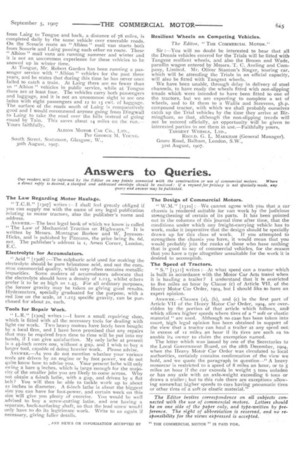Answers to Queries.
Page 25

If you've noticed an error in this article please click here to report it so we can fix it.
Our readers Will be informed by the Editor on any points connected with the construction or use of commercial motors. Where a direct reply is desired, a staniPed and addressed envelope should be enclosed : if a request for privacy is not specially made, any query and answer may be published.
The Law Regarding Motor Haulage.
" T.C.11" [1307] writes :—I shall feel greatly obliged if you can supply me with the name of any legal publication relating to motor tractors, also the publisher's name and address.
ANS WER. —The best legal book of which we know is called "The Law of Mechanical Traction on Highways." It is written by Messrs. Montague Barlow and W. JoynsonHicks, and is pubished by Pitmans, the price being 8s. 6d. net. The publisher's address is s, Amen Corner, London, E.C.
Electrolyte for Accumulators.
" Acid " [13081 :—The sulphuric acid used for making the electrolyte should be pure brimstone acid, and not the common commercial quality, which very often contains metallic impurities. Some makers of accumulators advocate that the electrolyte should have a density of 1.215, whilst others prefer it to be as high as 1.45. For all ordinary purposes, the former gravity may be taken as giving good results. Hydrometers, specially graduated for the purpose, with a red line on the scale, at 1.2 15 specific gravity, can be purchased for about 2s. each.
Tools for Repair Work. "
L. R." [1309] writes :—I have a small repairing shop, which is fitted with all the necessary tools for dealing with light car work. Two heavy motors have lately been bought by a local firm, and I have been promised that any repairs that may be required from time to time will be put into my hands, if I can give satisfaction. My only lathe at present is a 41-inch centre one, without a gap, and I wish to buy a larger tool, capable of doing heavier work. Please advise.
AN S WER.—As you do not mention whether your various tools are driven by an engine or by foot power, we do not quite know how to advise you. Your present lathe will only swing a bare 9 inches, which is large enough for the majority of the smaller jobs you are likely to come across. Why not obtain a 6-inch lathe, with a gap, and driven by a flat belt? You will then be able to tackle work up to about 22 inches in diameter. A 6-inch lathe is about the biggest size you can have for.foot-power, and certain work on this size will give you plenty of exercise. You would be well advised to buy a screw-cutting lathe, and one having a separate, back-surfacing shaft, so that the lead screw would only have to do its legitimate work. Write to •us again if necessary, giving fuller details.
The Design of Commercial Motors.
" W.M." [I310] : -We cannot agree with you that a car chassis is rendered suitable for van work by the judicious strengthening of certain of its patrts. It has been pointed out in the columns of this journal time after time, that the conditions under which any freight-carrying vehicle has to work, make it imperative that the design should be specially
drawn up for this class of work. If you attempted to strengthen the chassis you have, it would mean that you would probably join the ranks of those who have nothing that is good to say of commercial vehicles, for the reason that you have a type altogether unsuitable for the work it is desired to accomplish.
The Speed of Tractors.
"S." [1311] writes : -At what speed can a traetor which is built in accordance with the Motor Car Acts travel when
it is hauling a trailer? I understand that it restricted to five miles an hour by Clause (c) of Article VII. of the Heavy Motor Car Order, 1904, but I should like to have an expert opinion.
ANS IV ER.—Clauses (a), (b), and (c) in the first part of Article VII of the Heavy Motor Car Order, 1904, are overridden by the portion of that article which follows, an& which allows higher speeds where tires of a " soft or elastic material " are used. Although no case has been taken into court, high legal opinion has been obtained in support of the view that a tractor can haul a trailer at any speed not: in excess of 12 miles an hour if its tires are such as to enable its owner to claim the exemption named.
The letter which was issued by one of the Secretaries to the Local Government Board, on the 28th December, 1934, when the Heavy Mon* Car Order was circulated to local authorities, certainly contains confirmation of the view we hold, and we quote the paragraph in question—" A heavy motorcar is restricted to a speed of 8 miles an hour, or to 5 miles an hour if the car exceeds in weight 3 tons unladen or has any axle with an axle-weight exceeding 6 tons or draws a trailer; but to this rule there are exceptions allowing somewhat higher speeds to cars having pneumatic tires or other tires of a soft or elastic material.'
































